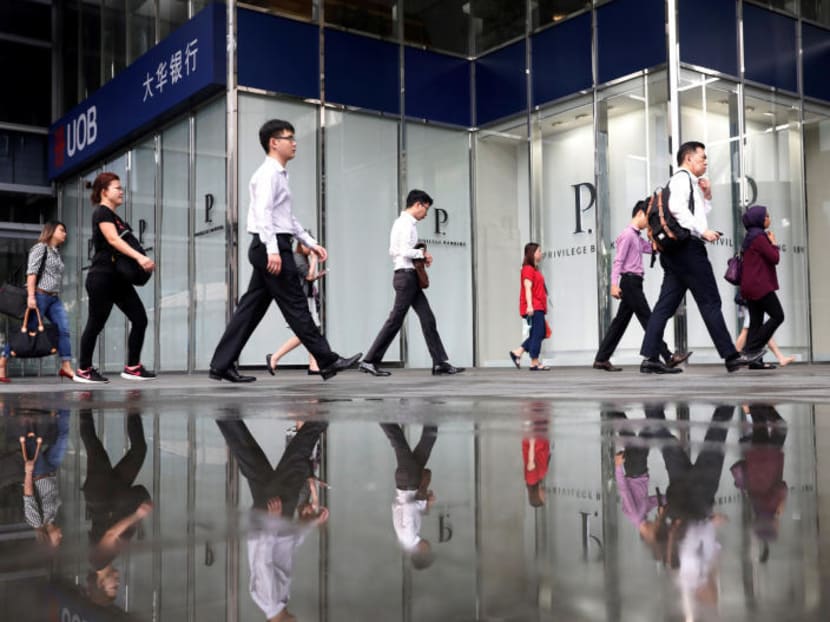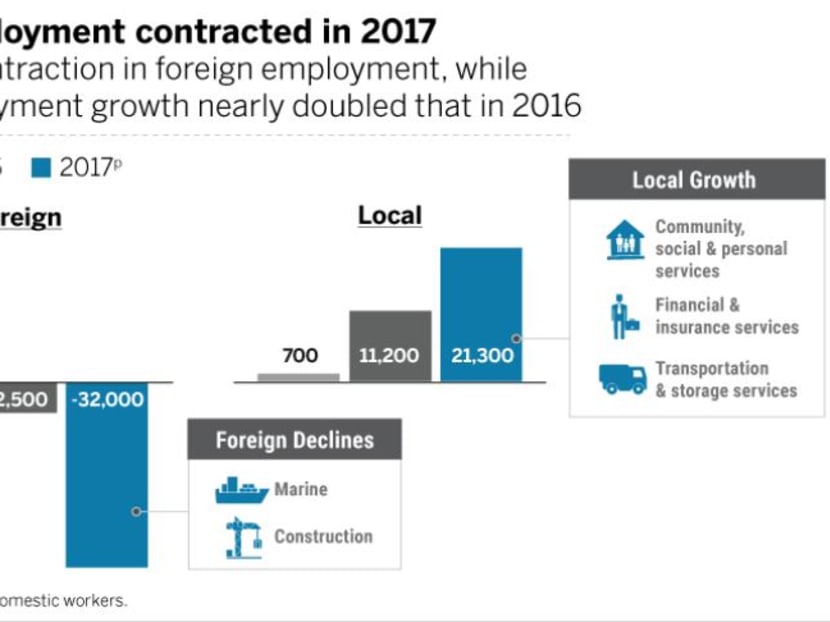Drop in foreign employment, but firms will still be dependent on foreign workers: Economists
SINGAPORE – Total employment for 2017 shrank for the first time in 14 years, due to a contraction in foreign employment. In contrast, local employment grew by an estimated 0.9 per cent last year, with some 21,300 jobs added.

Total employment in Singapore for 2017 shrank for the first time since 2003, declining by an estimated 10,700. REUTERS
SINGAPORE — The latest Ministry of Manpower (MOM) labour market report released on Friday (Jan 26) may have indicated a huge dip in foreign employment last year, but economists and human resource experts say that it should not be read as a sign that companies here have weaned off reliance on foreign workers.
This is because sectors such as healthcare and construction still rely heavily on foreign labour, and locals might not yet be qualified to take up certain vocations in IT and cybersecurity industries.
According to MOM’s preliminary statistics, foreign employment — excluding foreign domestic workers — shrank by 32,000 last year, mainly due to a decrease in work permit holders in construction and marine.
This is the largest drop in foreign employment since 2002, when the figure fell by 43,000.
The decline led to the economy hiring fewer workers on the whole for 2017, as Singapore’s total employment shrank for the first time since 2003, declining by an estimated 10,700.

Photo: MRSD/MOM
“Some industries still continue to be very dependent on foreign labour, such as marine and offshore,” said CIMB Private Banking economist Song Seng Wun.
He added that firms “will continue to hire more foreign workers, as long as the global economy continues to do better”.
Mr David Ang, director of corporate services at Human Capital Singapore, said: “(Hirers) may not be able to find enough Singaporeans to fill up roles in professions and vocations where the latest technology is used, for example certain roles in cyber security, some aspects of IT and e-commerce.”
Furthermore, it takes time to train locals in these areas where there is increased digitisation, added Mr Ang.
Maybank economist Chua Hak Bin said that foreign and local workers are not entirely substitutes, but can complement each other.
“Limiting the hiring of foreign workers will constrain companies from growing and investing in sectors like healthcare, technology and even retail, where there is a shortage of local workers available.”
On the other hand, local employment grew by an estimated 0.9 per cent last year, with some 21,300 more Singaporeans and permanent residents hired.
This is nearly double the growth seen in 2016, where local employment increased by 11,200. The increase was due to expanded hiring in most services sectors such as community, social and personal services, financial and insurance services, and transportation services.
Economists told TODAY that this is an indication that the job market has turned the corner, as they credited strong external demand as the main reason for local employment growth.
“External demand has improved exports, and that had an impact on the supporting industries like finance, transport logistics, where we subsequently see more hiring,” said Mr Song.
“This indicates that the job market, on the whole, has turned the corner.”
Mr Bernard Aw, principal economist at IHS Markit, said: “The higher number of local jobs created last year suggests that firms are more optimistic about future business activity, in light of stronger economic growth.”
Though the pick up in total employment in the last quarter of 2017 was mainly due to seasonal hiring in the services sector, economists said that growth in local employment was also seen in sectors where more permanent hiring was observed.
“There are signs of permanent hiring, not only in temporary positions such as in retail, but in the finance, insurance and real estate sectors, for example. It shows that firms are a little more confident of growth, and are committing to hiring manpower,” said Mr Chua.
The latest jobs report also gave good cheer to workers, as retrenchment figures fell.
The number of retrenchments went down in 2017 compared with the year before, with 14,340 retrenchments last year compared with 19,170 in 2016. This bucked the trend of rising layoffs in the last six years.
In the last quarter of 2017, the number of retrenchments was 3,300, similar to the previous quarter, which saw about 3,400 retrenchments. The decline over the year was observed across the manufacturing, construction and services sectors.
Despite a rosier outlook in terms of employment and falling retrenchments, the MOM cautioned that the continued economic restructuring will pose some challenges.
“Job-skills mismatch continues to be a growing structural challenge due to ongoing economic restructuring and shifts in the composition of the resident labour force,” said the Ministry in a statement accompanying the labour report.
The average unemployment rate for Singaporeans last year went up to 3.3 per cent, compared with 3.1 per cent in 2016.
On average, 70,600 residents — including 62,600 citizens — were unemployed in 2017. The corresponding figures in 2016 were lower at 67,400 and 59,100 respectively.
Mr Ang said: “Middle-aged Professional, Managers, Executives and Technicians (PMETs), who are mid-way through their careers are particularly vulnerable. They might find that it is harder to get back into jobs after being retrenched or displaced due to tech advancements.”
“They need to be re-skilled and must be prepared to take on new jobs, but more must be done to secure their employment and make sure they are gainfully employed.”






